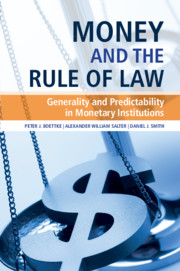Book contents
- Money and the Rule of Law
- Money and the Rule of Law
- Copyright page
- Dedication
- Contents
- Preface
- Acknowledgments
- 1 Introduction
- 2 Knowledge Problems with Discretionary Monetary Policy
- 3 Incentive Problems with Discretionary Central Banking
- 4 When Firefighters Are Arsonists
- 5 On the Shoulders of Giants
- 6 Money and the Rule of Law
- 7 Conclusion
- Index
- References
7 - Conclusion
Money and Liberalism in the Twenty-First Century
Published online by Cambridge University Press: 13 May 2021
- Money and the Rule of Law
- Money and the Rule of Law
- Copyright page
- Dedication
- Contents
- Preface
- Acknowledgments
- 1 Introduction
- 2 Knowledge Problems with Discretionary Monetary Policy
- 3 Incentive Problems with Discretionary Central Banking
- 4 When Firefighters Are Arsonists
- 5 On the Shoulders of Giants
- 6 Money and the Rule of Law
- 7 Conclusion
- Index
- References
Summary
We conclude by situating the theory and practice of monetary policy within liberal political economy more generally. As we have seen, there are significant tensions between existing monetary institutions (discretionary central banking) and liberal ideals. This has been made even clearer by the Federal Reserve’s response to COVID-19. In brief, the Fed is now engaging in not only monetary policy but fiscal policy as well. This represents an immense expansion in its mandate, one that poses serious challenges for general and predictable monetary policy. The way out of this mess is embracing a comparative institutions approach to monetary policy. We cannot be satisfied with technical refinements to existing models and data. We need to explore alternative monetary policy rules, ones that are effective at providing macroeconomic stability while also respecting the requirements of democracy.
- Type
- Chapter
- Information
- Money and the Rule of LawGenerality and Predictability in Monetary Institutions, pp. 167 - 184Publisher: Cambridge University PressPrint publication year: 2021

